Solid Waste Management: Analytical Hierarchy Process (AHP) Ppplication of Selecting Treatment Technology in Sepang Municipal Council, Malaysia
Mohd Armi Abu Samah1 * , Latifah Abd Manaf1 , Ahmad Zaharin Aris1 and Wan Nor Azmin Sulaiman1
1
Department of Environmental Sciences,
Faculty of Environmental Studies,
Universiti Putra Malaysia,
43400 UPM Serdang,
Selangor
Malaysia
DOI: http://dx.doi.org/10.12944/CWE.6.1.01
The main issues with solid waste management today are to identify and select the most appropriate solid waste treatment technologies as well as disposal method in selected areas. However the decision making process is getting more complicated especially dealing with its cost efficiency. Thus, the Analytical Hierarchy Process (AHP) was chosen to use as tools to facilitate the decision making task. It is a method developed to support multi-criteria decisions, effective and practical approach that consider complex and unstructured decision. One model was developed as General Hierarchy Structure Model (GHSM) for selecting an appropriate solid waste treatment technology. The models was structured into hierarchy consists of goal, criteria subcriteria and alternatives. Based on political support, technical expertise, environmental impact, market potential, community involvement and cost critera, GHSM will give priority to recycling, composting, incineration or combination of technologies. The case study in Sepang Municipal Council, have shown that the combination of recycling and composting technology is the best alternative and suitable in Sepang area.
Copy the following to cite this article:
Samah M.A.A, Manaf L.A, Aris A.z, Sulaiman W.N.A. Solid Waste Management: Analytical Hierarchy Process (AHP) Ppplication of Selecting Treatment Technology in Sepang Municipal Council , Malaysia . Curr World Environ 2011;6:01-16 DOI:http://dx.doi.org/10.12944/CWE.6.1.01
Copy the following to cite this URL:
Samah M.A.A, Manaf L.A, Aris A.z, Sulaiman W.N.A. Solid Waste Management: Analytical Hierarchy Process (AHP) Ppplication of Selecting Treatment Technology in Sepang Municipal Council , Malaysia . Curr World Environ 2011;6;01-16. Available from: http://www.cwejournal.org?p=304/
Download article (pdf)
Citation Manager
Publish History
Select type of program for download
| Endnote EndNote format (Mac & Win) | |
| Reference Manager Ris format (Win only) | |
| Procite Ris format (Win only) | |
| Medlars Format | |
| RefWorks Format RefWorks format (Mac & Win) | |
| BibTex Format BibTex format (Mac & Win) |
Article Publishing History
| Received: | 2011-01-11 |
|---|---|
| Accepted: | 2011-02-15 |
Introduction
Waste generally means ‘something unwanted’. Its precise definition and scope however, differs from one country to another (Kaseva and Mbuligwe 2005). Waste is something for which we have no further use and which we wish to get rid. Solid wastes arises from unusable residue in raw materials, leftovers, rejects and scrap from process operations, used or scrap packaging materials and even saleable products themselves when they are finally discarded (Tchobanoglous et al. 1993).
Solid waste management is one of the three major environmental problems faced by municipalities in Malaysia (World Bank 1993). In Malaysia, solid waste generated consists of a heterogeneous mixture of materials including paper, glass, metal, organic material, plastic in varying quantities – it is inevitable by – product of human activities. It is estimated that currently 17,000 tonnes of solid waste is generated daily in Peninsular Malaysia, and this estimation will increase to more than 30,000 tonnes per day by 2020 consequent upon the increasing population and per capita waste generation (MHLG 2005)
The amount of solid waste generated in large cities of developing countries is expected to increase significantly due to the rapid increase in population, urbanization, improvements in the standard of living and the changing of live style (Gottinger, 1991; Hassan, 2000). As a result from the huge amount of solid waste generated, many developing countries are facing serious problems in the disposal of their waste (Hassan, 2000). It is becoming more difficult to find the suitable landfill sites within the collection areas and at the same time, the remaining operating lifespent of existing landfill sites is short. Uncontrolled generation of solid waste and minimal waste reduction and recycling at sources has shortened further the life span of these sites (Hassan 2000).
The selection of treatment technology and disposal of solid waste vary from one country to another and depends on the types of waste, composition, infrastructure, land availability, labour, economic aspects, recycling strategy, public awareness, calorific value of waste, energy availability and demand, and environmental impact (Agamuthu 2001). There is no universal best system for waste treatment and disposal (White et al. 1995). The selection of the best system for any given region can only be determined locally depending on both the composition and the quantities of waste generated, the availability of the disposal technologies (such as incinerator), and the market demand for the product derived from waste treatment (such as reclaimed material, compost and energy) (White et al. 1995). According to Wilson (1981) the selection criteria of the appropriate technologies for solid waste treatment and disposal depend on several criteria and these include economic, technical, environmental, and political objectives.
Basically the main objective of the study is to structured solid waste management problems into hierarchy to assist in decision making process in order to select the best and appropriate technology for solid waste management. Therefore Analytical Hierarchy Process (AHP) approach which was developed by Saaty (1980) was used in this study. Generally in the AHP, a problem is structured into a hierarchy. Which normally consists four levels of hierarchy structure such as goal level, criteria level , subcriteria level and alternative levels.
Methodology
Sepang Municipal Council (MPS) which used to be called Sepang District Council and change to its later name on 13th December 2005, under the Department of Environmental Health in Sepang district. Sepang district service has an area of 60 hectares and total population is about 55,000 (1991), 75,000 (1999) and to reach about 2.2 million people in year 2020. Basically Sepang Municipal Council district covers an area which is divided into three parts viz: Dengkil (29,395 hectares), Labu (29,395 hectares) and Sepang (2,044 hectares). These entire districts have a growth population reaching to 2.2 million. By having a huge area with a big community, a wide variety of solid waste is produced including organic, inorganic, commercial and landscape waste. The estimated solid waste generated in Sepang district is about 100 tonne perday, 3,000 tonne per month or 3,600 per year.
 |
Table 1: Data Analysis for Selection of GHSM Subcriteria Click here to View table |
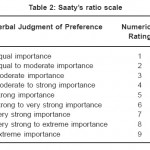 |
Table 2: Saaty’s ratio scale Click here to View table |
With the Stead by increasing in the number of people, it will also affect the generation rate and composition of solid waste in the area. Thus, Analytical Hierarchy Process (AHP) is suitable to be applied in solid waste management because it can help in making decision in selecting solid waste treatment more specifically and effectively. Basically, this is due to the fact that AHP being a hierarchy analysis technique which supports the creating process in various criteria and complex problem made easy. According to the explanation principle, of AHP pairwise comparison matrix and synthesis can further prove the choosing and suggestion process of certain technology effectively and suitable with the least cost. Therefore, Sepang Municipal Council who has responsibility to manage solid waste in the area should have and implement treatment technology for their solid waste in order to extend the life span of their landfill.
The AHP methodology basically are approached to (i) structure the decision into objectives and alternatives; (ii) measure objectives and alternatives using pairwise comparison; (iii) synthesise objectives; (iv) exploit subjective inputs in order to reach a prioritised list alternatives (Bertolini et al. 2006).
Basically this study has developed one model in solid waste management problems, namely General Hierarchy Structure Model (GHSM). GHSM was firstly steps are developed and consists of goal; criteria, subcriteria and alternative, and it were based 20 solid waste management textual sources and 30 questionnaires were distributed. The development of the hierarchy is fundamental to explain the problem structure more clearly and specifically. Figure 1 show hierarchy structure for GHSM which consist of 1 goal (to select an appropriate technology), 6 criteria (political support, technical expertise, environmental impact, market potential, community involvement and cost), 12 subcriteria and 7 alternatives.
 |
Table 3: Example Pairwise Comparison Matrix for Recycling Click here to View table |
 |
Table 4: First Level Pairwise Comparison Matrix: Criteria to Goal Click here to View table |
In order to determine sub-criteria for GHSM, 30 questionnaire surveys were distribute to solid waste expert consist of academician, researchers, stackholders, decision makers, policy makers in Putrajaya, Kuala Lumpur, Serdang, Bangi and Kajang in the Selangor state area. The selection of subcriteria was carried out using the Delphi method where those with the highest percentage in will be considered as subcriteria for GHSM. The following (1) was used to analysis the average value of the given scales and Table 1 show then data analysis for selected subcriteria to be filled in General Hierarchy Structure Model (GHSM).

n = Number of question
aij = Parallel Value
j = Vertical
m = Total of vertical value
The second step, was to do a pairwise comparison to the elements in the hierarchy. The scale ranges between 1-9 for pairwise comparison value according to Saaty scale following in table 2. Thus, numerical value is used as relative intensity of criteria if the alternatives are to be compared according to these criteria. Table 3 showed the example of pairwise comparison matrix constructed.
The third step was to synthesis the priority where it will rank the technology based on their benefits relative to the goal. Beside that’s, the performance of pairwise comparison also being tested. The following performance calculation (2) was used as a governance equation to find the maximum value of Eigenvector, consistency index CI, consistency ratio CR, and normalized value for each criteria or alternative as below.

Where λ max is the maximal or principal Eigenvector, and n is the matrix size, aij is and elements of pairwise comparison matrix, wj and wi is the j and i elements of values of Eigenvector, respectively. Therefore as a general rule, a consistency ratio of 0.10 or less is considered acceptable and the all data who obtained can use without any repeat procedure.

Results and Discussion
Table 5.36 show the pairwise comparison matrix between criteria to goal with the value acquired from Sepang municipal council expert. Thus the weight is vector for each of the comparison table and has to be coefficients to subcriteria.
After we obtained the result for the chosen appropriate technology based on the weight. Thus the next process is to select the solid waste treatment technology based on a specific technology with used PCM for selecting the highest weight of recycling technologies and select the specific weights for the weight composting. Specifically as a result of PCM is that we can choose the specific technology to be applied at the Sepang Municipal Council with better and effectively. Below are PCM analyses for specific recycling hierarchy and composting matrix.
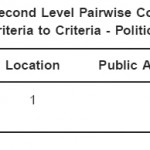 |
Table 4.1: Second Level Pairwise Comparison Matrix: Subcriteria to Criteria - Political Support Click here to View table |
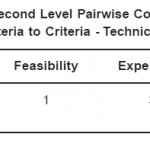 |
Table 4.2: Second Level Pairwise Comparison Matrix: Subcriteria to Criteria - Technical Expertice Click here to View table |
Figure 4 shows the results of AHP analysis for General Hierarchy Structure Model. The value for pairwise comparison was provided by solid waste practitioner in Sepang Municipal Council. The overall results shown that the combinations of recycling and composting technology were in the first ranking with the highest value (0.13), followed by incineration (0.12), combination of recycling and incineration technology (0.10), combination of composting and incineration technology (0.09), recycling (0.08), composting (0.07), and lastly combination of recycling, composting and incineration technology (0.07).
Basically the value for pairwise comparison was found consistent where CR was below 0.1 otherwise, we need to revise the elements of the matrix to improve consistency. The original expectation was that a 10% consistency ratio (CR) is required for valid results (Saaty, 1980). If the comparisons are not perfectly consistent, then the AHP technique will provides a mechanism for improving consistency. It has been suggested that consistency is particularly difficult when decision-makers consider sustainable development aspect (Noble, 2004). Thus at the final stage, a basic sensitivity analysis was performed to test the sensitivity of the outcome and determine the critical evaluation criteria that affect the selection.
 |
Table 4.3: Second Level Pairwise Comparison Matrix: Subcriteria to Criteria - Environmental Impact Click here to View table |
 |
Table 4.4: Second Level Pairwise Comparison Matrix: Subcriteria to Criteria - Market Potential Click here to View table |
 |
Table 4.5: Second Level Pairwise Comparison Matrix: Subcriteria to Criteria - Community Involvement Click here to View table |
 |
Table 4.6: Second Level Pairwise Comparison Matrix: Subcriteria to Criteria - Cost Click here to View table |
 |
Table 4.7: Third Level Pairwise Comparison Matrix: Alternative to Subcriteria – Location (L) Click here to View table |
 |
Table 4.8: Third Level Pairwise Comparison Matrix: Alternative to Subcriteria - Public Acceptance (P.A) Click here to View table |
 |
Table 4.9: Third Level Pairwise Comparison Matrix: Alternative to Subcriteria – Feasibility (F) Click here to View table |
 |
Table 4.10: Third Level Pairwise Comparison Matrix: Alternative to Subcriteria Experience (E) Click here to View table |
 |
Table 4.11: Third Level Pairwise Comparison Matrix: Alternative to Sub criteria - Water Pollution (W.P) Click here to View table |
 |
Table 4.12: Third Level Pairwise Comparison Matrix: Alternative to Subcriteria -Public Health (P.H) Click here to View table |
 |
Table 4.13: Third Level Pairwise Comparison Matrix: Alternative to Subcriteria - Estimates Cost (E.C) Click here to View table |
 |
Table 4.14: Third Level Pairwise Comparison Matrix: Alternative to Subcriteria - Financial Management (F.M) Click here to View table |
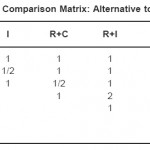 |
Table 4.15: Third Level Pairwise Comparison Matrix: Alternative to Subcriteria - Cooperation (Co) Click here to View table |
 |
Table 4.16: Third Level Pairwise Comparison Matrix Alternative to Subcriteria - Interest Message (I.M) Click here to View table |
 |
Table 4.18: Third Level Pairwise Comparison Matrix: Alternative to Subcriteria - Capital Cost (C.C) Click here to View table |
 |
Table 4.19: Third Level Pairwise Comparison Matrix: Alternative to Subcriteria Operation Cost (O.C) Click here to View table |
 |
Table 4.20: The Ranking of Solid Waste Treatment Technology Click here to View table |
 |
Table 5.1: First Level Pairwise Comparison Matrix of Recycling: Criteria to Goal Click here to View table |
 |
Table 5.2: Second Level Pairwise Comparison Matrix of Recycling: Alternative to Criteria -Location Click here to View table |
 |
Table 5.3: Second Level Pairwise Comparison Matrix of Recycling: Alternative to Criteria -Collection Effective Click here to View table |
 |
Table 5.4: Second Level Pairwise Comparison Matrix of Recycling: Alternative to Criteria -Participation Click here to View table |
 |
Table 5.5: Second Level Pairwise Comparison Matrix of Recycling: Alternative to Criteria -Value of Material Click here to View table |
 |
Table 5.6: The overall results for the specific selecting of recycling technology Click here to View table |
 |
Table 5.7: First Level Pairwise Comparison Matrix of Specific Composting: Criteria to Goal Click here to View table |
 |
Table 5.8: Second level pairwise comparison matrix of specific composting: Alternative to criteria - community Click here to View table |
 |
Table 5.9: Second level pairwise comparison matrix of specific composting: Alternative to criteria - available Click here to View table |
 |
Table 5.10: Second level pairwise comparison matrix of specific composting: Alternative to criteria - operation Click here to View table |
 |
Table 5.11: Second level pairwise comparison matrix of specific composting: Alternative to criteria - operation Click here to View table |
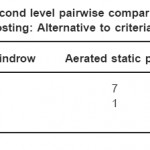 |
Table 5.12: Second level pairwise comparison matrix of specific composting: Alternative to criteria -maintenance Click here to View table |
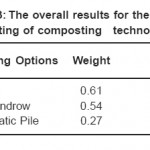 |
Table 5.13: The overall results for the specific selecting of composting technology Click here to View table |
Fig. 5 showed the plot radar for ranking weight. Based on the plot radar, combination of R+C is at top line and very suitable to practice as well as to be implement. These result also obviously based on variation in the criteria weight impact the ranking of the alternatives in order to found the best selection of solid waste treatment technology in Sepang Municipal Council.
 |
Figure 1: Case study area in Sepang Municipal Council Click here to View figure |
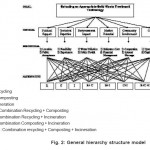 |
Figure 2: General hierarchy structure model Click here to View figure |
 |
Figure 3: Flow Chart of the AHP Step Measurement Click here to View figure |
 |
Figure 4: AHP analysis for general hierarchy structure model Click here to View figure |
 |
Figure 5: Plot radar selecting solid waste treatment technology Click here to View figure |
Conclusion
This paper presents the application of Analytical Hierarchy Process procedure to assist solid waste practitioner to choose the best and appropriate treatment technology for Sepang area. By using AHP procedure, both subjective and objective evaluation measures were considered in decision making process. Besides, AHP also provides a useful mechanism for checking the consistency of the evaluation measure thus reducing bias in decision making.
The Analytical Hierarchy Process not only offers some advantages over traditional decision methods, but it can integrate with those other approaches to take advantage of the strength inherent in each. Considering the complexity of most management issue in solid waste management at Sepang, the AHP can extend to a wide array of managerial and planning. The overall performance was evaluated to be satisfactory based on the case studies in Malaysia. This decision making tool is useful in avoiding ill-informed decisions where expertise and resources are scarce.
Acknowledgements
The authors would like to thank Ministry of Sciences, Technology and Innovation (MOSTI), Malaysia for sponsoring this research under Science Fund Research Grant (01-01-04-SF0675).
References
- Agamuthu, P., Solid waste: principles and management with Malaysian case studies. Institute of Biological science, University of Malaya, Kuala Lumpur (2001).
- Bertolini M,; Braglia, M.; Carmignani, G., Application of the AHP methodology in making a proposal for a public work contract. International Journal of Project Management (2006) 2(4): 422-430.
- Gottinger, W.H., Economic models and application of solid waste management. Gordon and Breach Science Publisher: S.A (1991).
- Hassan, M.N., Policies to improve solid waste management in developing countries: some insights in Southeast Asian Countries. Proceedings of the 2nd International Conference on Solid Waste Management: Perspective of the 21st Century. March, Taipei, Taiwan. (2000) 22-25.
- Kaseva, M. E.; Mbuligwe, S.E., Appraisal of solid waste collection following private sector involvement in Dar es Salaam city, Tanzania. Habitat Internationanal (2005) 29: 353-366
- Ministry of Housing & Local Government., The strategic plan for solid waste management. – Local Government Department, (2005) volume 1.
- Noble, B.F., Strategic environmental assessment quality assurance: Evaluating and improving the consistency of judgments in assessment panels. Environmental impact assessment review, (2004) 24: 3-25.
- Saaty, T.L., The Analytic Hierarchy Process. McGraw Hills. New York. World Bank. Malaysia: managing costs of urban pollution. Report No 1764-MA. The World Bank. Washington D.C (1993).
- Saaty, T.L., The Analytical Hierarchy Process. McGraw-Hill Publication (1980).
- Tchobanoglous, G.; Thiesen. H.; Vigil S.A. Integrated solid waste management, Engineering principles and management issues. Mc Graw-Hill International Edition. California. (1993) 193-245.
- White, P.R.; Franke, M.; Hindle, P., Integrated solid waste management – A lifecycle inventory. Blackie academic & professional (Chapman and hall): London (1995).
- Wilson, D.C., Waste Management: Planning, Evaluation, Technologies. Oxford. Oxford University Press: New York (1981).






